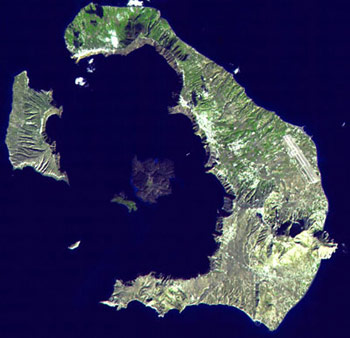
Aegean Neolithic and Bronze Age Civilizations:
Conflict and Calamity
Earthquakes, often severe and ruinous, were frequent in Minoan times. According to most scholars, this was the main cause of the several reconstructions of not only the palaces but of settlements as well.
The first palace at Knossos was built around 1900 BCE on the ruins of previous settlements. It was destroyed for the first time along with the other palaces around Crete in 1700 BCE, probably by a large earthquake or foreign invaders. It was immediately rebuilt to become an even more elaborate complex until its demise.

In 1628 BCE a massive volcanic eruption occurred on the island of Thera (modern day Santorini), 100 km north of Crete. It was one of the most violent volcanic eruptions ever since human beings have been on this planet. According to Robert Ballard, National Geographic Explorer, an estimated 14 cubic miles of magma belched out of the mountain’s crater, causing massive tsunamis and blackening the skies over 115,000 square miles. Waves from 60 miles away moved stone walls on Crete over 200 feet and buildings were buried in volcanic ash, cities were devastated, shock waves destroyed the island’s navy and volcanic ash killed its crops.
It was one of the most violent volcanic eruptions ever since human beings have been on this planet.
The myth of the lost continent of Atlantis was probably passed on to the Greeks from the Egyptians whose trading partners, the Minoans, suddenly stopped coming to visit their shores. Stories drifted southward about an island blown into the sea which the Egyptians assumed was Crete. This was in all likelihood Thera—a map found in Crete depicts Thera as similar in shape to the Atlantis described by Plato. He most likely got the story via Critias the Younger, a relative of Solon who may well have heard an original version while in Egypt. The story is found in its most complete form in Plato’s dialogues, Timaeus and Critias.
This eruption weakened the Minoans and left them vulnerable to frequent and growing raids from the Myceneans from the Greek mainland—administrative records from this next period are written in Linear B, the script of Mycenaean Greeks. Contemporary pottery shows a blend of Minoan and Mycenaean stylistic traits. The final end of the Minoan civilization was about 1200 BCE after which there is no evidence of the culture. The Mycenaean Greeks had taken over.
